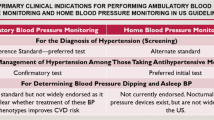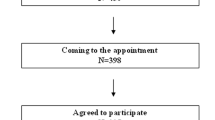Abstract
Failing to reach blood pressure (BP) goals is one of the main problems in hypertension management. Especially in high-risk patients, intensive monitoring including frequently office visits or new techniques to monitor home BP is required. A total of 60 patients with uncontrolled hypertension were included and randomized into a group with telemetric BP monitoring (TBPM) (n=30) and a control group receiving standard care (n=30). During the 3-month study period, patients received in addition to their antihypertensive pre-treatment up to 2 × 300 mg irbesartan to achieve the required target BP. All patients were instructed to measure their BP once daily in the morning. In the TBPM group automatic alerts were generated by the central database server using pre-defined algorithms and patients were subsequently contacted by the physician. At baseline mean 24-h ambulant BP monitoring (ABPM) was 143.3±11.1/82.6±9.9 mm Hg in the TBPM group and 141.4±12.6/82.1±6.5 mm Hg in the standard care group. During treatment mean systolic BP showed a more intensive decrease in the TBPM vs control group (−17.0±11.1 mm Hg vs −9.8±13.7 mm Hg; P=0.032). Patients in the TBPM group had a more pronounced night dipping and a higher reduction of mean pulse pressure than controls (−8.1±5.9 mm Hg vs −2.8±7.4 mm Hg, P=0.004). After 3 months, TBPM-treated patients were given a higher mean daily dose of irbesartan (375±187 mg vs 222±147 mg in controls; P=<0.001). We demonstrated that with TBPM a more effective and faster titration of the antihypertensive agent is possible. The alarm criteria chosen were useful to improve BP control.
This is a preview of subscription content, access via your institution
Access options
Subscribe to this journal
Receive 12 digital issues and online access to articles
$119.00 per year
only $9.92 per issue
Buy this article
- Purchase on Springer Link
- Instant access to full article PDF
Prices may be subject to local taxes which are calculated during checkout





Similar content being viewed by others
References
Meisinger C, Heier M, Volzke H, Lowel H, Mitusch R, Hense HW et al. Regional disparities of hypertension prevalence and management within Germany. J Hypertens 2006; 24 (2): 293–299.
Wolf-Maier K, Cooper RS, Banegas JR, Giampaoli S, Hense HW, Joffres M et al. Hypertension prevalence and blood pressure levels in 6 European countries, Canada, and the United States. JAMA 2003; 289 (18): 2363–2369.
Lopez AD, Mathers CD, Ezzati M, Jamison DT, Murray CJ . Global and regional burden of disease and risk factors, 2001: systematic analysis of population health data. Lancet 2006; 367 (9524): 1747–1757.
Lowel H, Meisinger C, Heier M, Hymer H, Alte D, Volzke H . [Epidemiology of hypertension in Germany. Selected results of population-representative cross-sectional studies]. Dtsch Med Wochenschr 2006; 131 (46): 2586–2591.
Erdine S, Aran SN . Current status of hypertension control around the world. Clin Exp Hypertens 2004; 26 (7–8): 731–738.
Mancia G, De Backer G, Dominiczak A, Cifkova R, Fagard R, Germano G et al. 2007 Guidelines for the Management of Arterial Hypertension: The Task Force for the Management of Arterial Hypertension of the European Society of Hypertension (ESH) and of the European Society of Cardiology (ESC). J Hypertens 2007; 25 (6): 1105–1187.
Yakovlevitch M, Black HR . Resistant hypertension in a tertiary care clinic. Arch Intern Med 1991; 151 (9): 1786–1792.
Parati G, Stergiou GS, Asmar R, Bilo G, de Leeuw P, Imai Y et al. European Society of Hypertension guidelines for blood pressure monitoring at home: a summary report of the Second International Consensus Conference on Home Blood Pressure Monitoring. J Hypertens 2008; 26 (8): 1505–1526.
Pickering TG, Miller NH, Ogedegbe G, Krakoff LR, Artinian NT, Goff D . Call to action on use and reimbursement for home blood pressure monitoring: Executive Summary. A joint scientific statement from the American Heart Association, American Society of Hypertension, and Preventive Cardiovascular Nurses Association. J clin hypertens (Greenwich, Conn) 2008; 10 (6): 467–476.
Hobbs FD, Erhardt L . Acceptance of guideline recommendations and perceived implementation of coronary heart disease prevention among primary care physicians in five European countries: the Reassessing European Attitudes about Cardiovascular Treatment (REACT) survey. Fam Pract 2002; 19 (6): 596–604.
Parati G, Valentini M . Do we need out-of-office blood pressure in every patient? Curr Opin Cardiol 2007; 22 (4): 321–328.
Mengden T, Hernandez Medina RM, Beltran B, Alvarez E, Kraft K, Vetter H . Reliability of reporting self-measured blood pressure values by hypertensive patients. Am J Hypertens 1998; 11 (12): 1413–1417.
van der Hoeven NV, van den Born BJ, Cammenga M, van Montfrans GA . Poor adherence to home blood pressure measurement schedule. J Hypertens 2009; 27 (2): 275–279.
Johnson KA, Partsch DJ, Rippole LL, McVey DM . Reliability of self-reported blood pressure measurements. Arch Intern Med 1999; 159 (22): 2689–2693.
Krecke HJ, Lutkes P, Maiwald M . Patient assessment of self-measurement of blood pressure: results of a telephone survey in Germany. J Hypertens 1996; 14 (3): 323–326.
Mengden T, Vetter H, Tisler A, Illyes M . Tele-monitoring of home blood pressure. Blood press monit 2001; 6 (4): 185–189.
Pare G, Jaana M, Sicotte C . Systematic review of home telemonitoring for chronic diseases: the evidence base. J Am Med Inform Assoc 2007; 14 (3): 269–277.
Rossing K, Schjoedt KJ, Jensen BR, Boomsma F, Parving HH . Enhanced renoprotective effects of ultrahigh doses of irbesartan in patients with type 2 diabetes and microalbuminuria. Kidney Int 2005; 68 (3): 1190–1198.
Weinberg AJ, Zappe DH, Ramadugu R, Weinberg MS . Long-term safety of high-dose angiotensin receptor blocker therapy in hypertensive patients with chronic kidney disease. J Hypertens Suppl 2006; 24 (1): S95–S99.
Marino MR, Langenbacher K, Ford NF, Uderman HD . Pharmacokinetics and pharmacodynamics of irbesartan in healthy subjects. J Clin Pharmacol 1998; 38 (3): 246–255.
Reeves RA, Lin CS, Kassler-Taub K, Pouleur H . Dose-related efficacy of irbesartan for hypertension: an integrated analysis. Hypertension 1998; 31 (6): 1311–1316.
Menne J, Farsang C, Deak L, Klebs S, Meier M, Handrock R et al. Valsartan in combination with lisinopril versus the respective high dose monotherapies in hypertensive patients with microalbuminuria: the VALERIA trial. J Hypertens 2008; 26 (9): 1860–1867.
Elliott HL . Focus on the ONTARGET results. J Hypertens Suppl 2009; 27 (2): S8–S10.
Giles T . ONTARGET for hypertension or not? Curr Hypertens Rep 2008; 10 (4): 303–304.
Sengul AM, Altuntas Y, Kurklu A, Aydin L . Beneficial effect of lisinopril plus telmisartan in patients with type 2 diabetes, microalbuminuria and hypertension. Diabetes Res Clin Pract 2006; 71 (2): 210–219.
Sudano I, Noll G . Dual blockade versus single blockade of the renin-angiotensin system in the light of ONTARGET. J Hypertens Suppl 2009; 27 (2): S11–S14.
Rogers MA, Small D, Buchan DA, Butch CA, Stewart CM, Krenzer BE et al. Home monitoring service improves mean arterial pressure in patients with essential hypertension. A randomized, controlled trial. Ann Intern Med 2001; 134 (11): 1024–1032.
Friedman RH, Kazis LE, Jette A, Smith MB, Stollerman J, Torgerson J et al. A telecommunications system for monitoring and counseling patients with hypertension. Impact on medication adherence and blood pressure control. Am J Hypertens 1996; 9 (4 part 1): 285–292.
Pickering TG, Gerin W, Holland JK . Home blood pressure teletransmission for better diagnosis and treatment. Curr Hypertens Rep 1999; 1 (6): 489–494.
Staessen JA, Thijs L, Fagard R, O'Brien ET, Clement D, de Leeuw PW et al. Predicting cardiovascular risk using conventional vs ambulatory blood pressure in older patients with systolic hypertension. Systolic Hypertension in Europe Trial Investigators. Jama 1999; 282 (6): 539–546.
Hollenberg NK, Parving HH, Viberti G, Remuzzi G, Ritter S, Zelenkofske S et al. Albuminuria response to very high-dose valsartan in type 2 diabetes mellitus. J Hypertens 2007; 25 (9): 1921–1926.
Illyes M, Mengden T, Tisler A . The virtual hypertension clinic. Blood Press Monit 2002; 7 (1): 67–68.
Vetter H, Mengden T, Kraft K . Verbesserung der langzeitkontrolle der arteriellen hypertonie mit blutdruckselbstmessung. Dtsch Arztebl 1998; 95 (45): 2833.
Acknowledgements
The study was supported by Sanofi-Aventis Deutschland GmbH.
Author information
Authors and Affiliations
Corresponding author
Ethics declarations
Competing interests
H Haller has received honoraria from Daiichi-Sankyo, Sanofi-Aventis, Amgen, Roche, Recordati, Takeda, Astra-Zeneca, Berlin-Chemie and Novartis. J Menne has received honoraria from Daiichi-Sankyo, Novartis and Berlin Chemie. The other authors declare that they have no conflict of interest with this paper.
Rights and permissions
About this article
Cite this article
Neumann, C., Menne, J., Rieken, E. et al. Blood pressure telemonitoring is useful to achieve blood pressure control in inadequately treated patients with arterial hypertension. J Hum Hypertens 25, 732–738 (2011). https://doi.org/10.1038/jhh.2010.119
Received:
Revised:
Accepted:
Published:
Issue Date:
DOI: https://doi.org/10.1038/jhh.2010.119
Keywords
This article is cited by
-
Optimizing blood pressure control by an Information Communication Technology-supported case management (PIA study): study protocol for a cluster-randomized controlled trial of a delegation model for general practices
Trials (2021)
-
Telemonitoring und E-Health bei arterieller Hypertonie
Der Internist (2021)
-
Is antihypertensive treatment based on home blood pressure recommended rather than that based on office blood pressure in adults with essential hypertension? (meta-analysis)
Hypertension Research (2019)
-
The Japanese Society of Hypertension Guidelines for the Management of Hypertension (JSH 2019)
Hypertension Research (2019)
-
Effectiveness of home blood pressure telemonitoring: a systematic review and meta-analysis of randomised controlled studies
Journal of Human Hypertension (2017)



